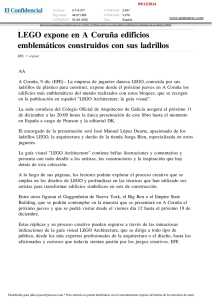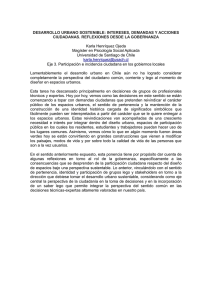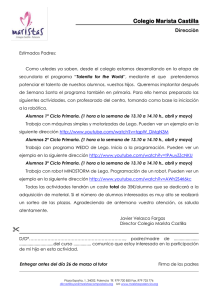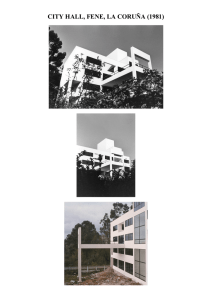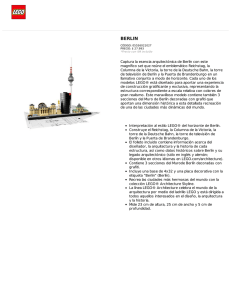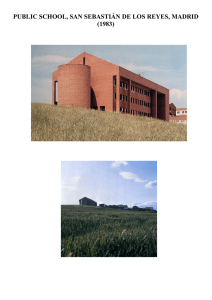Flatiron Building Le Flatiron Building Edificio Flatiron
Anuncio
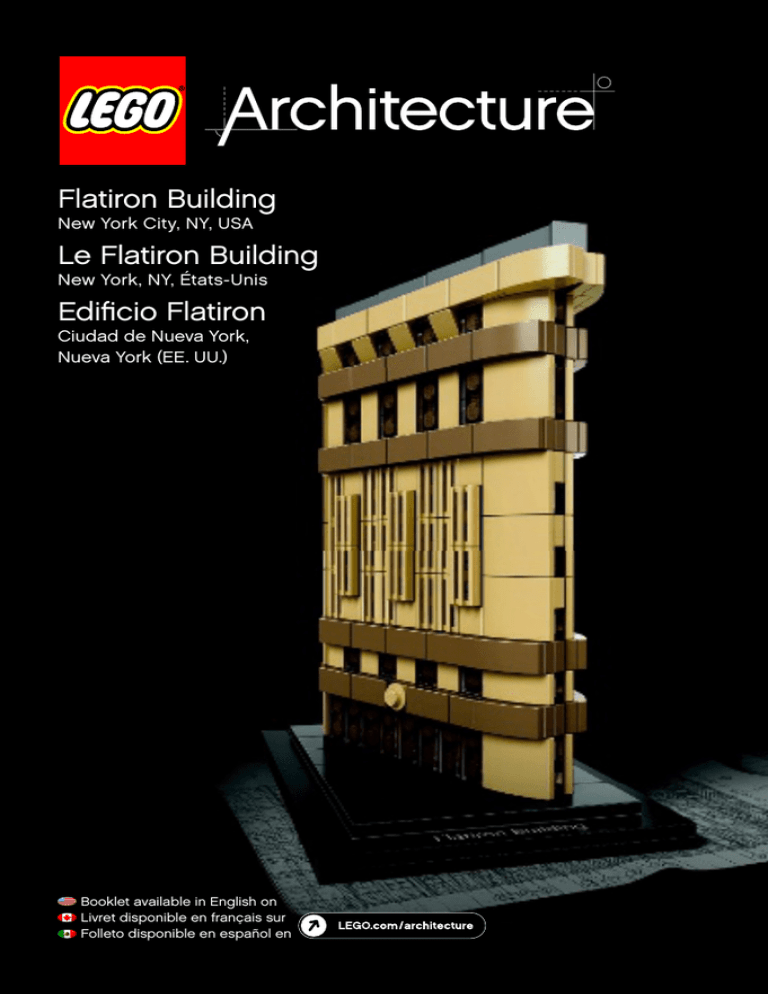
Flatiron Building New York City, NY, USA Le Flatiron Building New York, NY, États-Unis Edificio Flatiron Ciudad de Nueva York, Nueva York (EE. UU.) Booklet available in English on Livret disponible en français sur Folleto disponible en español en Flatiron Building Sitting on the intersection where Fifth Avenue and Broadway cross, the Flatiron Building (originally named the Fuller Building) remains one of New York City’s most popular and memorable structures. Today it is difficult to imagine the controversy this architectural landmark created on its completion in 1902. [ I found myself agape, admiring a sky-scraper... ploughing up through the tra∞c of Broadway and Fifth Avenue in the afternoon light. ] H. G. Wells, 1906 2 3 © Per Tropp-Christiansen History As the city of New York expanded northward during the second half of the 19th century, small plots of land in between or on the edge of new buildings remained undeveloped. One of the most well known of these was the narrow triangular site at 23rd Street, between Fifth Avenue and Broadway. The “Flat Iron,” as it quickly became known, changed owners many times, but wouldn’t be developed until the Chicago-based Fuller Company bought the site in 1901. The Fuller Company, a major Chicago-based contracting firm specializing in the construction of skyscrapers, planned to build a new showcase headquarter on the site. The founder of the company, George A. Fuller, had died the year before, and the new building would be named the Fuller Building in his honor. Burnham saw the building as a vertical Renaissance palazzo with Beaux-Arts, or neoclassical, styling. Visually the building would be divided into three distinct sections. It would consist of a richly decorated, threestory limestone façade at the bottom and a broad, repetitive midsection in a light tan monochrome terra cotta. The structure would then be topped off with a crowning cornice that would run the entire length of the building. 4 © GettyImages The Fuller Company engaged Chicago architect Daniel H. Burnham to design the building and, utilizing the Fuller Company’s expertise with steel frame construction, he proposed a 20-story structure that would reach a height of 285 ft. (86.9 m). A penthouse would be added in 1905, increasing the building’s height to 307 ft. (93 m). The building’s Broadway front would be 190 ft. (60 m) wide, the Fifth Avenue front 173 ft. (52.7 m) wide, and the 22nd Street side just short of 87 ft. (26.5 m) wide. At the “point” of the triangle the building would only be 6.5 ft. (2 m) wide and would form a 25-degree acute angle. © GettyImages With its steel skeleton structure, the construction of the building was carried out rapidly and without major incident. While other New York skyscrapers at the time were often thin towers rising from pedestal-like blocks, the Flatiron was a single massive structure. This radical design, combined with its great height and unusual shape, created a great deal of debate as the building neared completion in 1902. Many New Yorkers believed the structure would be unstable and would fall over at the first gust of wind. The building had even been nicknamed “Burnham’s Folly” and bets were placed on how far the debris would reach when it blew over. Strong winds came and went, and the Flatiron Building withstood them—as it continues to do today, over a century later. It is proof that the structure was not only a strong architectural idea, but a groundbreaking engineering marvel as well. 5 The Architect Born in New York and raised in Chicago, Daniel H. Burnham would become one of the founding fathers of the first Chicago School of architects. Together with his then-partner John W. Root, Burnham built one of the first American skyscrapers, the 21-story Masonic Temple Building in Chicago in 1892, and planned the architectural layout of the largest World Fair ever held at that time in 1893. Burnham’s early sketches for the Flatiron Building included a clock face and a far more elaborate crown at the top of the building, but he was persuaded to remove both by his former partner John W. Root. Although Burnham retained overall control of the project, he engaged the architect F. P. Dinkelberg (1859–1935) to carry out most of the supervising work during the actual construction. After the Flatiron Building, Burnham would continue to work on a series of impressive architectural Daniel Hudson Burnham (1846 – 1912) projects, including a number of major planning tasks for the cities of San Francisco, Washington, D.C., and Manila in the Philippines. At the time of his death in 1912, his D. H. Burnham & Co. architectural firm was the largest in the world. 6 © Wikipedia Burnham’s architecture mixed elements of Modernism with a more neoclassical style. Many of his buildings, including the Flatiron Building, followed the convention of the classical column: three distinct parts made up of a base, a middle section, and an ornate cornice at the top. © Wikipedia © Wikipedia Plan for the development of Manila, submitted to the Philippine Commission by D. H. Burnham, 1905 Plan for San Francisco by Daniel Burnham and William Bennett, published 1906 7 8 © Per Tropp-Christiansen The Building Today Although never the tallest building in New York, or even the first building in the country with a triangular ground plan, the Flatiron Building remains an iconic symbol of the city of New York. Its enduring popularity with tourists, artists, and photographers also makes it one of the most photographed buildings in the world. The famous building has appeared in countless movies, TV series, and comics. It was home to Peter Parker’s Daily Bugle in the Spiderman movies, and was even accidently destroyed by the U.S. Army in the 1998 film Godzilla. The building was designated a New York City Landmark in 1966, added to the National Register of Historic Places in 1979, and became a National Historic Landmark in 1989. Valued today at $190 million, the Flatiron Building continues to function as a popular retail and office space, and is home to a large number of U.S. and international companies. In 2009, Sorgente Group of America acquired the majority stake of the Flatiron Building. Sorgente Group of America is the American Holding of Sorgente Group, an Italian real estate investment company. [ ... appeared to be moving toward me like the bow of a monster ocean steamer—a picture of a new America still in the making. ] Photographer Alfred Stieglitz 9 Facts about Flatiron Building Location: ........................................ Architect: ...................................... Style: .............................................. Materials: .................................... New York City, USA D. H. Burnham & Co: Daniel H. Burnham Renaissance Revival with Beaux-Arts styling Steel frame structure, façade of limestone and terra-cotta Height: .......................................... 1902: 285 ft. (86.9 m). Today: 307 ft. (93 m). Weight: ......................................... 3,680 tons (3,338.5 metric tons) Opened: ...................................... 1902 10 11 © Shutterstock Le Flatiron Building Situé à l'intersection de la Cinquième avenue et de Broadway, le Flatiron Building (appelé à l'origine Fuller Building) reste l'une des structures les plus populaires et les plus mémorables de New York. Il est aujourd'hui difficile d'imaginer la controverse que ce monument architectural suscita lorsque sa construction prit fin en 1902. [ Je me trouvais stupéfait, à admirer un gratte-ciel... en avançant dans la circulation de Broadway et de la Cinquième avenue dans la lumière de l'après-midi. ] H. G. Wells, 1906 12 13 © Per Tropp-Christiansen Histoire Alors que la ville de New York s'étendait vers le nord pendant la deuxième moitié du 19e siècle, de petites parcelles de terrain entre les nouveaux bâtiments ou alentour restaient non construites. L'une des plus célèbres était un étroit terrain triangulaire situé au carrefour de la 23e rue, la Cinquième avenue et Broadway. Le « Flat Iron », comme il fut rapidement connu, changea de propriétaires de nombreuses fois, mais rien n'y fut construit jusqu'à ce que la société Fuller de Chicago achète le terrain en 1901. La société Fuller, une grande entreprise de Chicago spécialisée dans la construction de gratte-ciels, prévoyait de construire un nouveau siège social spectaculaire sur ce site. Le fondateur de l'entreprise, George A. Fuller, était décédé l'année précédente, et le nouveau bâtiment serait nommé Fuller Building en son honneur. Burnham voyait le bâtiment comme un palazzo vertical de la Renaissance avec un style BeauxArts ou néoclassique. Le bâtiment serait séparé visuellement en trois sections distinctes. Il serait composé d'une façade en pierre calcaire richement décorée pour les trois étages du bas, et d'une section intermédiaire large et répétitive en terre cuite monochrome beige clair. La structure serait ensuite couronnée d'une corniche sur toute la longueur du bâtiment. 14 © GettyImages La société Fuller engagea l'architecte de Chicago Daniel H. Burnham pour concevoir le bâtiment. S'inspirant de l'expertise de la société Fuller en matière de construction à charpente d'acier, Burnham proposa une structure de 20 étages qui atteindrait une hauteur de 86,9 m. Un penthouse allait être ajouté en 1905, augmentant la hauteur du bâtiment à 93 m. La façade du bâtiment sur Broadway devait mesurer 60 m de large, la façade sur la Cinquième avenue 52,7 m de large et le côté sur la 22e rue seulement un peu moins de 26,5 m de large. À la « pointe » du triangle, le bâtiment ne mesurerait que 2 m de large et formerait un angle aigu de 25 degrés. © GettyImages Grâce à la charpente en acier, la construction du bâtiment fut effectuée rapidement et sans incident majeur. Alors que d'autres gratte-ciels de New York à l'époque étaient souvent de fines tours s'élevant à partir de blocs ressemblant à des piédestaux, le Flatiron était une structure massive unique. Ce design radical, combiné avec sa grande hauteur et sa forme inhabituelle, suscita beaucoup de débats lorsque la construction du bâtiment prit fin en 1902. De nombreux New-yorkais pensaient que la structure allait être instable et tomberait au premier coup de vent. Le bâtiment avait même été surnommé la « folie de Burnham », et des paris furent placés sur la distance qu'atteindraient les débris lorsqu'il s'écroulerait. Des vents forts allaient et venaient, et le bâtiment Flatiron leur résistait, comme il continue de le faire aujourd'hui, plus d'un siècle plus tard. Ceci est une preuve que la structure était non seulement une idée architecturale forte, mais aussi une merveille d'ingénierie. 15 L’architecte Né à New York et élevé à Chicago, Daniel H. Burnham allait devenir l'un des pères fondateurs de l'École d'architecture de Chicago. Avec son partenaire de l'époque, John W. Root, Burnham construisit en 1892 l'un des premiers gratte-ciels américains, le bâtiment de 21 étages du temple maçonnique de Chicago, et créa en 1893 le plan architectural de la plus grande foire mondiale jamais organisée à l'époque. Les premières esquisses de Burnham pour le Flatiron incluaient une horloge en façade et une couronne beaucoup plus élaborée en haut du bâtiment, mais il fut convaincu de supprimer ces deux éléments par son ancien partenaire John W. Root. Burnham conserva le contrôle général du projet, mais il engagea l'architecte F. P. Dinkelberg (1859–1935) pour effectuer la majorité du travail de supervision pendant la construction. Après le Flatiron Building, Burnham Daniel Hudson Burnham (1846 – 1912) continua à travailler sur une série de projets architecturaux impressionnants, notamment plusieurs grands travaux de planification pour les villes de San Francisco, Washington, D.C., et Manille aux Philippines. Au moment de sa mort en 1912, son cabinet d'architecture, D. H. Burnham & Co., était le plus grand du monde. 16 © Wikipedia L'architecture de Burnham mélangeait des éléments du Modernisme avec un style plus néoclassique. Beaucoup de ses bâtiments, y compris le Flatiron, suivaient les conventions de la colonne classique : trois parties distinctes, avec une base, une section intermédiaire et une corniche ornementée en haut. © Wikipedia © Wikipedia Plan pour le développement de Manille, soumis à la Commission philippine par D. H. Burnham, 1905 Plan pour San Francisco par Daniel Burnham et William Bennett, publié en 1906 17 18 © Per Tropp-Christiansen Le bâtiment aujourd’hui Le Flatiron n'a jamais été le plus haut bâtiment de New York, ni même le premier immeuble du pays avec un plan triangulaire, mais il reste cependant un symbole célèbre de New York. Sa popularité auprès des touristes, des artistes et des photographes en fait aussi l'un des bâtiments les plus photographiés au monde. Ce célèbre bâtiment est apparu dans d'innombrables films, séries télé et bandes dessinées. Il abritait le journal Daily Bugle de Peter Parker dans les films de Spiderman et fut même accidentellement détruit par l'armée américaine dans le film Godzilla de 1998. Le bâtiment devint un bâtiment historique de la ville de New York en 1966, fut ajouté au registre national des lieux historiques en 1979, et devint un monument historique national en 1989. Évalué aujourd'hui à 190 millions de dollars, le Flatiron Building continue de servir d'espace populaire de bureaux et de magasins, et abrite de nombreuses sociétés américaines et internationales. En 2009, le Sorgente Group of America acquit une participation majoritaire dans le Flatiron Building. Sorgente Group of America est la société de portefeuille américaine du Sorgente Group, une entreprise italienne d'investissement immobilier. [ ... semblait avancer vers moi comme la proue d’un énorme transatlantique, une image d’une nouvelle Amérique en construction. ] Alfred Stieglitz, photographe 19 Informations sur le Flatiron Building Lieu : .................................................. Architecte : .................................. Style : ............................................. Matériaux : ................................. New York, États-Unis D. H. Burnham & Co : Daniel H. Burnham Néo-Renaissance avec style Beaux-Arts Charpente en acier, façade en pierre calcaire et terre cuite Hauteur : ..................................... 1902 : 86,9 m. Aujourd’hui : 93 m. Poids : ........................................... 3 338,5 tonnes Inauguration : ........................... 1902 20 21 © Shutterstock Edificio Flatiron Situado en el cruce entre la Quinta Avenida y Broadway, el Edificio Flatiron (bautizado como «Edificio Fuller») continúa siendo una de las estructuras más populares y emblemáticas de la ciudad de Nueva York. Hoy es difícil imaginar la controversia que generó este hito arquitectónico cuando se inauguró en 1902. [ Me encontré a mí mismo boquiabierto, admirando un rascacielos... abriéndome paso a través del tráfico de Broadway y la Quinta Avenida bajo la luz de la tarde. ] H.G. Wells, 1906 22 23 © Per Tropp-Christiansen Historia La expansión hacia el Norte que experimentó la ciudad de Nueva York durante la segunda mitad del siglo XIX dio lugar a la aparición de pequeños espacios sin construir entre los nuevos edificios o junto a ellos. Uno de los más populares era el estrecho terreno triangular de la Calle 23, entre la Quinta Avenida y Broadway. El «Flat Iron», como comenzó a conocerse poco después, cambió de propietario varias veces, pero ninguno de ellos se decidió a construir en él hasta que Fuller Company, una compañía con sede en Chicago, adquirió el sitio en 1901. Fuller Company, una importante firma contratista con sede en Chicago especializada en la construcción de rascacielos, planeaba construir una nueva sucursal que le sirviese de escaparate. El fundador de la compañía, George A. Fuller, había muerto un año antes, y el nuevo edificio se bautizaría como «Edificio Fuller» en su honor. Burnham concibió el edificio como un palazzo renacentista de estilo «Beaux-Arts» o neoclásico. Visualmente, el edificio se dividiría en tres secciones diferentes. De este modo, se compondría de una fachada de tres plantas en piedra caliza generosamente decorada en la parte inferior, y una amplia sección central iterativa en terracota marrón claro. Finalmente, la estructura quedaría coronada por una cornisa que recorrería la totalidad del perímetro del edificio. 24 © GettyImages Fuller Company encargó el diseño del edificio a Daniel H. Burnham (un arquitecto de Chicago), quien, aprovechando la experiencia de Fuller Company en la construcción de estructuras de acero, propuso un edificio de 20 plantas que alcanzaría una altura de 86,9 m. En 1905 se construiría un ático que elevaría la altura del edificio hasta los 93 m. La fachada del edificio orientada hacia Broadway poseería 60 m de anchura; la orientada hacia la Quinta Avenida, 52,7 m; y la orientada hacia la Calle 22, tan sólo 26,5 m. En la «punta» del triángulo, el edificio mediría sólo 2 m de ancho y formaría un ángulo agudo de 25 grados. © GettyImages Gracias a su estructura de acero, la construcción del edificio tuvo lugar rápidamente y sin mayores inconvenientes. Mientras que otros rascacielos neoyorquinos de la época eran a menudo comparables a una delgada torre construida con bloques a modo de pedestal, el Edificio Flatiron era una única y enorme estructura. Este radical diseño, sumado a su gran altura e inusual forma, dio lugar a intensas discusiones cuando la construcción se acercaba a su final en 1902. Muchos neoyorquinos creían que la estructura sería inestable y se derrumbaría con la primera ráfaga de viento. Algunos incluso apodaron el edificio como «la locura de Burnham» y apostaron a la distancia que alcanzarían los escombros cuando fuese derribado. Fuertes vientos fueron y vinieron, y el Edificio Flatiron los soportó… y continúa soportándolos hoy, más de un siglo después. Es una prueba de que la estructura no sólo era una sólida idea arquitectónica, sino también una revolucionaria maravilla de la ingeniería. 25 El arquitecto La arquitectura de Burnham mezclaba elementos de modernismo con otros más neoclásicos. Muchos de sus edificios, incluido el Flatiron, respetaron la convención de la columna clásica, compuesta por tres partes diferentes: una base, una sección central y una cornisa ornamental en la parte superior. Los primeros esquemas del Edificio Flatiron bosquejados por Burnham incluían un reloj y una cornisa más elaborada, pero su antiguo socio (John W. Root), lo convenció para que eliminase ambas cosas. Aunque Burnham mantuvo el control del proyecto en general, contrató al arquitecto F. P. Dinkelberg (1859–1935) para que llevase a cabo la mayor parte del trabajo de supervisión durante la construcción. Daniel Hudson Burnham (1846 – 1912) Después de trabajar en el Edificio Flatiron, Burnham continuó trabajando en una serie de impresionantes proyectos arquitectónicos, entre ellos el planeamiento urbanístico de ciudades como San Francisco, Washington, D.C. y Manila (Filipinas). Cuando murió en 1912, su estudio de arquitectos (D. H. Burnham & Co.) era el más grande del mundo. 26 © Wikipedia Nacido en Nueva York y criado en Chicago, Daniel H. Burnham se convertiría en uno de los padres fundadores de la primera Escuela de Chicago de arquitectura. Junto con su entonces socio, John W. Root, Burnham construyó uno de los primeros rascacielos de América (el edificio del Templo Masónico de Chicago, de 21 plantas, en 1892) y planificó el diseño arquitectónico de la feria mundial más grande jamás celebrada en 1893. © Wikipedia © Wikipedia Planeamiento urbanístico de Manila, presentado a la Comisión Filipina por D. H. Burnham en 1905 Planeamiento urbanístico de San Francisco, por Daniel Burnham y William Bennett, publicado en 1906 27 28 © Per Tropp-Christiansen El edificio en la actualidad Incluso sin haber sido nunca el edificio más alto de Nueva York (ni siquiera el primer edificio del país de planta triangular), el Edificio Flatiron continúa siendo un emblema de la ciudad de Nueva York. Su permanente popularidad entre turistas, artistas y fotógrafos lo ha convertido, además, en uno de los edificios más fotografiados del mundo. El popular edificio ha aparecido en innumerables películas, series para televisión y cómics. En él se encuentra la supuesta sede del Daily Bugle, el periódico en el que trabaja Peter Parker en las películas de Spiderman, e incluso fue accidentalmente destruido por el ejército de los EE. UU. en Godzilla (1998). El edificio fue declarado patrimonio de la ciudad de Nueva York en 1966 e inscrito en el Registro Nacional de Lugares Históricos en 1979, y se convirtió en Monumento Histórico Nacional de EE. UU. en 1989. Valorado en 190 millones de dólares, el Edificio Flatiron sigue albergando comercios y oficinas, y es la sede de un gran número de compañías estadounidenses e internacionales. En 2009, Sorgente Group of America adquirió la mayor parte del Edificio Flatiron. Sorgente Group of America es el brazo americano de Sorgente Group, una compañía italiana de inversión inmobiliaria. [ ...parecía avanzar hacia mi como la proa de un monstruoso transatlántico; una imagen de una nueva América aún en construcción. ] Alfred Stieglitz, fotógrafo 29 Ficha de características del Edificio Flatiron Situación: ....................................... Arquitecto: ................................... Estilo: ............................................. Materiales: ................................. Ciudad de Nueva York (EE. UU.) D. H. Burnham & Co: Daniel H. Burnham Neorrenacentista con elementos «Beaux-Arts» Estructura de acero, fachada de piedra caliza y terracota Altura: ............................................ 1902: 86,9 m; hoy: 93 m Peso: .............................................. 3.338,5 toneladas métricas Inauguración: ........................... 1902 30 31 © Shutterstock [ What the Parthenon was to Athens, the Flatiron Building is to New York. ] Photographer Alfred Stieglitz [Ce que le Parthénon était à Athènes, le Flatiron est à New York.] Alfred Stieglitz, photographe [ Lo que el Partenón fue para Atenas, el Edificio Flatiron lo es para Nueva York. ] Alfred Stieglitz, fotógrafo 32 33 34 LEGO.com/brickseparator 35 1x 1 1x 2 36 2x 2x 2x 3 1x 4 37 2x 1x 5 4x 6 38 4x 8x 1x 1x 1x 7 1x 1x 8 39 1x 1x 9 1x 1x 1x 1x 10 40 1 1x 2 2x 1x 2x 11 1x 1x 12 41 1x 1x 13 2x 14 42 1x 1x 1x 15 1x 1x 16 43 1x 1x 17 1x 18 44 1x 1x 1x 1x 19 45 1x 20 46 2x 1x 1x 21 Due to the site’s resemblance to a clothes iron it was called the “Flat Iron” long before the building itself was constructed. En raison de la ressemblance du terrain avec un fer à repasser, il fut appelé le « Flat Iron » (fer à repasser en anglais) bien avant la construction du bâtiment. El parecido entre la forma del sitio y una plancha le valió el apodo «Flat Iron» (plancha, en inglés) mucho antes de que se proyectase la construcción del edificio. ©Shutterstock 47 1x 22 48 1x 1x 2x 2x 2x 3x 2x 4x 2x 23 3 1 4 2 5 49 50 6 8 7 9 The steel for the building’s skeleton frame came from the American Bridge Company mills in Pennsylvania, U.S. L’acier pour la charpente du bâtiment fut fourni par l’aciérie American Bridge Company en Pennsylvanie, aux États-Unis. El acero de la estructura del edificio se produjo en las fábricas de American Bridge Company, en Pensilvania (EE. UU.). ©Veronica Mainetti 51 1x 24 52 1x 1x 1x 1x 2x 1x 1x 25 53 1x 26 54 1x 1x 1x 1x 27 During the peak construction of the steel frame, builders were adding a new story every day. Au plus fort de la construction de la structure en acier, les ouvriers ajoutaient un nouvel étage chaque jour. En el momento álgido de la construcción de la estructura de acero, los obreros lograron progresar a una planta por día. ©Veronica Mainetti 55 2x 28 56 1x 1x 1x 1x 29 57 2x 30 58 1x 1x 1x 1x 2x 1x 1x 31 3 1 4 2 5 59 60 1x 1x 1x 32 61 1x 33 62 1x 1x 1x 1x 34 63 1x 35 64 1x 1x 1x 36 Six Otis Company hydraulic elevators were installed in the building, powered by water pressure and pistons that activated a system of ropes and pulleys. Six ascenseurs hydrauliques de la société Otis furent installés dans le bâtiment, actionnés par la pression de l’eau et des pistons qui activaient un système de cordes et de poulies. Otis Company equipó el edificio con seis elevadores alimentados por presión hidráulica y pistones que activaban un sistema de cables y poleas. ©Wikipedia 65 1x 37 66 1x 2x 38 67 1x 4x 3x 1x 1x 1 7x 2 68 2x 2x 2x 3 1x 1x 4 1x 39 69 1x 2x 1 2x 2 70 1x 3 6x 4 2x The windows are deliberately small in size to ensure the building appears even more substantial. Les fenêtres sont délibérément de taille réduite afin que le bâtiment paraisse encore plus monumental. Las ventanas se hicieron pequeñas deliberadamente para que el edificio pareciese aún más robusto. ©Veronica Mainetti 71 3x 12x 5 6x 6 72 3x 6x 4x 2x 2x 7 8 2x 73 40 74 2x 1x 1x 1 3x 4x 1x 2 75 1x 2x 3 3x 4 76 4x 1x 4x 1x 3x 1x 2x 1x 5 1x 6 77 41 78 1x 1 2x 2 2x 2x 2x 4x The façade includes many Italian and French Renaissance motifs, such as Greek faces and terracotta flowers. La façade inclut de nombreux motifs de la Renaissance italienne et française, notamment des visages grecs et des fleurs en terre cuite. La fachada incluye numerosos elementos decorativos inspirados en el Renacimiento italiano y francés, como los rostros griegos y las flores de terracota. ©Veronica Mainetti 79 2x 2x 3 2x 4x 4x 4 4x 80 1x 5 2x 2x 6 81 42 82 1x 1x 1x 1 2x 2x 4x 2 2x 83 2x 2x 4x 3 2x 2x 4 2x 84 4x 4x 5 4x 85 43 86 8x 3 4x 1x 4x 1 1x 2 1x 2x 3x 1x 4 87 1x 1x 1x 3x 1x 1x 5 3 88 1 4 2 5 1x 6 89 44 90 1x 1 2x 2x 2 91 1x 3 2x 4 92 2x 6x 3x 5 15x 6 93 8x 7 6x 8 94 2x 2x 3x 3x 1x 3x 9 1 4 2 5 3 6 95 2x 10 96 45 97 4x 1x 1x 3 1x 1x 1x 1 1x 2 98 4x 4 1x 2x 4x 1x 4x 5 4x 4x 6 99 1x 3x 1x 1x 1x 1x 7 3 100 1 4 2 5 1x 8 101 46 102 2x 3 1x 1x 1 1x 1x 4 1x 2 2x 1x 5 103 1x 1x 6 8 1x 7 104 1x 2x 9 1x 1x 1x 10 1x 11 The upper floor originally housed a restaurant and an observation deck, both now closed. L’étage supérieur abritait à l’origine un restaurant et un site d’observation, mais les deux sont maintenant fermés. Al principio, la planta superior albergaba un restaurante y una plataforma de observación, ambos cerrados en la actualidad. ©Veronica Mainetti 105 47 106 107 LEGO® Architecture – Then and Now There has always been a natural connection between the LEGO® brick and the world of architecture. Fans who build with LEGO elements instinctively develop an interest in the form and function of the structures they create. At the same time, many architects have discovered that LEGO bricks are the perfect way of physically expressing their creative ideas. This connection was confirmed in the early 1960s with the launch of the LEGO “Scale Model” line. It matched the spirit of the age where modern architects were redefining how houses look and people were taking an active interest in the design of their new homes. These sets were designed to be different from the normal, brightly colored LEGO boxes; they also included a book on architecture as a source of inspiration. 21050 LEGO Architecture Studio 108 Decades later, architect and LEGO fan Adam Reed Tucker revived the idea of expressing architecture using LEGO bricks and in partnership with the LEGO Group, launched the LEGO Architecture line that we know today. His first models, and the original sets in the current LEGO Architecture series, were interpretations of famous skyscrapers from his hometown of Chicago. Since then LEGO Architecture has developed and evolved, first with well-known buildings from other cities in the United States, and now with iconic structures from Europe, the Middle East, and Asia. The introduction of our LEGO Architecture Studio set echoes the ambitions of the earlier LEGO “Scale Model” line and widens the potential of the LEGO Architecture series. Now you can enjoy building and learning about specific landmark buildings, or create exciting architectural models from your own fantasy. An inspiring 270-page book, featuring a number of renowned architects from around the world, guides you through the principles of architecture and encourages you in your own creative building. 109 LEGO® Architecture – Hier et aujourd’hui Il y a toujours eu une connexion naturelle entre la brique LEGO® et le monde de l’architecture. Les fans qui construisent avec des éléments LEGO développent instinctivement un intérêt pour la forme et la fonction des structures qu’ils créent. De nombreux architectes ont quant à eux découvert que les briques LEGO sont la façon idéale d’exprimer physiquement leurs idées de création. Cette connexion a été confirmée au début des années 1960 avec le lancement de la gamme « Maquettes à l’échelle » LEGO. Elle correspondait à l’esprit de l’époque, alors que les architectes modernes redéfinissaient les maisons, et que les gens s’intéressaient activement à la conception de la maison de leurs rêves. Ces ensembles originaux étaient conçus pour être différents des boîtes LEGO habituelles aux couleurs vives, et incluaient aussi « un livret d’architecture » comme source d’inspiration. Des décennies plus tard, l’architecte et fan LEGO Adam Reed Tucker a fait revivre l’idée d’exprimer l’architecture en utilisant des briques LEGO. En partenariat avec le Groupe LEGO, il lança la gamme LEGO Architecture que nous connaissons aujourd’hui. Ses premiers modèles, et les modèles originaux dans la gamme LEGO Architecture actuelle, étaient des interprétations de célèbres gratteciel de sa ville natale de Chicago. La gamme LEGO Architecture a depuis évolué et s’est transformée, tout d’abord avec des bâtiments célèbres d’autres villes des États-Unis et maintenant avec de célèbres structures d’Europe, du Moyen-Orient et d’Asie. L’introduction de notre ensemble LEGO Architecture Studio fait écho aux ambitions de la précédente gamme « Maquettes à l’échelle » LEGO et élargit le potentiel de la gamme LEGO Architecture. Vous pouvez maintenant apprécier et découvrir des bâtiments historiques ou créer de passionnants modèles architecturaux nés de votre imagination. Un livre d’inspiration de 270 pages, présentant plusieurs architectes célèbres du monde entier, vous guide parmi les principes de l’architecture et vous encourage dans votre propre construction créatrice. 110 LEGO® Architecture: entonces y ahora Siempre ha existido una conexión natural entre el brick LEGO® y el mundo de la arquitectura. Los fans que construyen con elementos LEGO desarrollan instintivamente un interés por la forma y las funciones de las estructuras que crean. Al mismo tiempo, muchos arquitectos han descubierto que los bricks LEGO son una forma perfecta de expresar físicamente sus ideas creativas. Esta relación se confirmó a principios de la década de 1960, con el lanzamiento de la línea «Scale Model» de LEGO. Encajaba bien con el espíritu de la época: un tiempo en el que los arquitectos modernos redefinían el aspecto de las casas y la gente se interesaba cada vez más por el diseño de su nuevo hogar. Los sets se diseñaron para que se diferenciasen de los normales, que se comercializaban en cajas de brillantes colores, e incluían un libro sobre la arquitectura que proporcionaba inspiración a sus usuarios. Décadas más tarde, el arquitecto y fan de LEGO Adam Reed Tucker reavivó la idea de expresar la arquitectura usando bricks LEGO y, en colaboración con The LEGO Group, lanzó la línea LEGO Architecture que hoy conocemos. Sus primeros modelos, y los sets originales de la actual serie LEGO Architecture, eran interpretaciones de los rascacielos más famosos de su ciudad natal, Chicago. Desde entonces, LEGO Architecture se ha desarrollado y ha evolucionado, primero incorporando edificios célebres de otras ciudades de Estados Unidos y, ahora, estructuras emblemáticas de Europa, Oriente Próximo y Asia. La introducción del set LEGO Architecture Studio recupera las ambiciones de la antigua línea «Scale Model» de LEGO y amplía el potencial de la serie LEGO Architecture. Hoy puedes disfrutar mientras construyes y aprendes sobre edificios célebres, o crear tus propios modelos arquitectónicos a partir de tu imaginación. Un instructivo libro de 270 páginas con materiales creados por arquitectos internacionales de gran reputación te guiará a través de los principios de la arquitectura y te animará a dar tus primeros pasos en el mundo de la construcción creativa. 111 Celebrate the world of architecture Célébrez le monde de l’architecture Celebra el mundo de la arquitectura 21017 Imperial Hotel Hôtel Imperial 21014 Villa Savoye 21006 The White House La Maison-Blanche 112 21013 Big Ben 21022 Lincoln Memorial Le monument de Lincoln Monumento a Lincoln 21018 United Nations Headquarters Le siège des Nations Unies and collect all the models et collectionnez tous les modèles y colecciona todos los modelos 21011 Brandenburg Gate La porte de Brandebourg 21015 The Leaning Tower of Pisa La tour penchée de Pise 21020 Trevi Fountain La fontaine de Trevi Fontana de Trevi 21019 The Eiffel Tower La tour Eiffel La torre Eiffel 21003 Seattle Space Needle 113 References Text credits: The Flatiron Building: The New York Landmark and the Incomparable City That Arose with It, Alice Sparberg Alexiou, Thomas Dunne Books, 2010. Photo credits: Shutterstock.com Wikipedia.org Veronica Mainetti, Sorgente Group of America Per Tropp-Christiansen Gettyimages.com Références Crédits textes : The Flatiron Building: The New York Landmark and the Incomparable City That Arose with It, Alice Sparberg Alexiou, Thomas Dunne Books, 2010. Crédits photos : Shutterstock.com Wikipedia.org Veronica Mainetti, Sorgente Group of America Per Tropp-Christiansen Gettyimages.com Referencias Redacción: The Flatiron Building: The New York Landmark and the Incomparable City That Arose with It, Alice Sparberg Alexiou, Thomas Dunne Books, 2010. Fotografías: Shutterstock.com Wikipedia.org Veronica Mainetti, Sorgente Group of America Per Tropp-Christiansen Gettyimages.com Customer Service Kundenservice Service Consommateurs Servicio Al Consumidor LEGO.com/service or dial 114 00800 5346 5555 : 1-800-422-5346 : 5x 4113915 18x 4109995 8x 4124455 6x 4162465 20x 4114026 10x 4121921 16x 6101254 2x 4211399 12x 6055172 1x 4211415 26x 4549436 4x 4113233 3x 4124067 2x 4161734 4x 4112982 10x 4528604 27x 4496699 2x 4565393 4x 4211429 9x 4211445 18x 4626904 4x 4211055 3x 4211425 2x 663626 2x 4568734 4x 6024495 9x 4516055 12x 6046922 1x 6101020 3x 416226 20x 6046924 8x 4560184 1x 6011459 1x 4211461 3x 4159553 4x 383226 21x 4125253 18x 6038458 45x 4124456 27x 4529685 21x 4113917 9x 6001197 10x 4211407 5x 4211389 1x 4211388 2x 4211408 12x 6014615 2x 6102769 4x 4515374 7x 4558953 2x 4211476 1x 4654448 115 LEGO and the LEGO logo are trademarks of the/sont des marques de commerce du/son marcas registradas de LEGO Group. ©2015 The LEGO Group. 6138981

